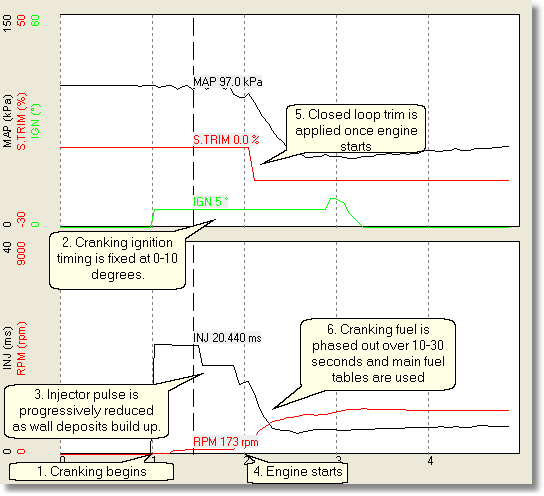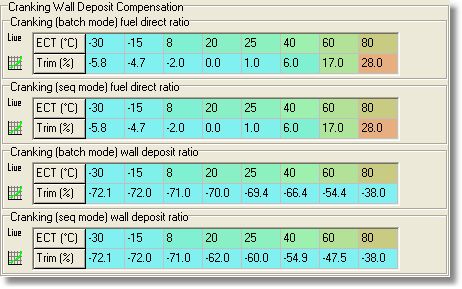Understanding the starting process
This datalog illustrates the events which occur when you start the engine.

When the engine is cranked (note 1), initially the ECU will use a large injector pulse, since much of the fuel will stick to the cold walls of the intake manifold and cylinder head. The injector pulse is calculated from the cranking fuel table, overall fuel trim, cranking fuel trim, air temperature and water temperature compensation tables. Fixed ignition timing is used (note 2), typically 5 or 7 degrees BTDC. As the engine cranks, the amount of fuel is reduced as the fuel wall deposits reaches equilibrium (note 3).
When the engine speed reaches 600 rpm the ECU determines that the engine has started (note 4). At this point the last closed loop start term fuel trim (from when the engine was shut off) is applied to the main table fuel. For the first 10-30 seconds of engine running the injector pulse is determined from both the cranking fuel and main fuel tables. At first only the cranking fuel is used, and is progressively replaced by the fuel value from the main fuel tables (note 6).
Troubleshooting Starting Problems
| 1. | Check the minimum battery voltage when cranking the engine, according to a datalog. The battery voltage should be around 10.5V, and should not drop below 9.2V |
| 2. | Check the engine rpm when cranking. The cranking rpm should be over 150 rpm when cold, and around 200 rpm when hot. |
| 3. | If you have altered the overall fuel trim, cranking fuel trim, injector voltage compensation, cranking air temperature fuel compensation or cranking water temperature fuel compensation, then test again with a new base calibration. |
| 4. | If the engine does not fire easily when cold, then it needs more cranking fuel. |
| 5. | If the engine does not always start when hot, then it either has too much cranking fuel or has a fuel vapor lock. |
| 6. | If the engine fires, but idles very low and roughly for several seconds or more, then it needs more cranking fuel. |
If you have determined that the engine needs more cranking fuel, or if the engine is hard to start and you don't know if it is too rich or too lean, then start by adding fuel. Increase the cranking fuel in 10% increments, up to 30%. Datalog each start, and determine which has the lowest cranking time and the quickest time to reach a fast idle. If adding fuel makes the cranking time worse, then try subtracting fuel, in -10% decrements, to a minimum of -30%.
Note that for testing you cannot start the engine from cold, switch it off, change the cranking fuel, then re-start the engine. If the engine is started, even for a few seconds, two things change which affects future starting - the intake valve warm up, which helps the fuel atomize, and fuel deposits on the intake manifold / cylinder head. Therefore it is best to leave the engine several hours, or preferably, overnight.
Once you establish the cranking fuel trim which works best for you engine & injectors, then you can either leave the change in the overall cranking fuel trim, or change the cranking water temperature fuel compensation. If the engine is hard to start for everything except a hot start, then change cranking fuel trim.
![]()
If the engine is only hard to start at one temperature, then you should change the cranking water temperature fuel compensation.

This compensation table specifies a reduction in fuel for all coolant temperatures. If you need to add fuel for one temperature range, then you need to increase the trim. Because these trims will all be negative, the numeric value will decrease. The exact equation to use is:
new trim = old trim + ((100 + old trim) x (change% / 100))
Eg to add 10% more cranking fuel at 50 degrees, change the trim from -70.0% to -67.0%
Cranking Wall Deposits
Warning: These are advanced tables and only should be altered by experienced tuners.
When cranking, or running for that matter, a certain amount of fuel sticks to the walls of the intake manifold and cylinder head. The amount of the fuel that sticks depends on the surface area of the ports, temperature of the cylinder head and amount of engine vacuum. The important things to know is that fuel both sticks to the walls and also is vaporized from the wall.
The ECU then must determine how much fuel gets in the cylinder fuel by working out how much was injected, how much sticks to the walls and how much is coming back off the walls. Typically this will give a much higher cranking pulse when first cranking from cold, as the ECU determines that a lot of fuel will get stuck on the walls, but then decreases to an equilibrium if you crank long enough.
When starting the engine the ECU will fire the injectors in batch for about two engine revolutions, then switch to sequential. This is so that it can start to try and start the engine sooner, as otherwise it has to wait for a complete revolution of the cam sensor to give the engine position. The upshot is that the wall deposit rates are different between batch and sequential modes. Thus there are two tables for each parameter - seq and batch.

The first table group is 'direct ratio' - which is the amount of fuel injected which makes it into the cylinder. Increasing these values will tell the ECU that more fuel will get to the cylinder, and therefore the ECU will decrease the injector duration.
The second table group is the 'wall deposit' - which is the amount of fuel which is sucked into the cylinder from the intake manifold / cylinder head. Increasing this value will also lower the injector duration.
These equations are dynamic, and the ECU is keeping track of the amount of fuel sitting in the intake as well. For example, if you raise the wall deposit value, then you'll see a reduction in injector duration after the engine starts as the ECU then thinks that a lot of fuel is being sucked into the cylinder from the cranking fuel which stuck to the walls.
If you're having problems with cold starts and flooding, then try increasing the direct ratio at that temperature.